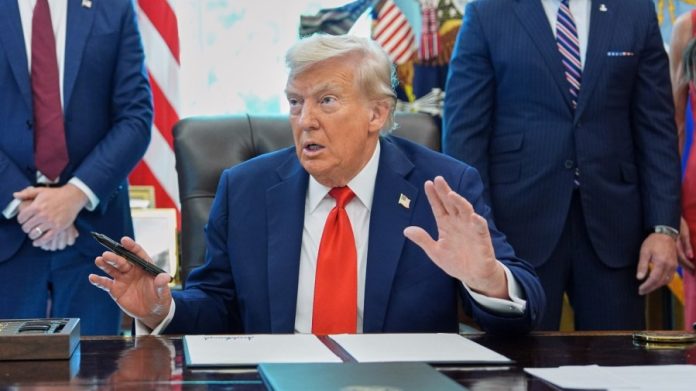
President Trump signed executive orders Monday threatening to upend the fledgling “cashless bail” policies that major cities including Washington, D.C., Los Angeles, New York City and Chicago have embraced in recent years.
“Cashless bail — we’re ending it, but we’re starting by ending it in D.C.,” Trump told reporters during a signing event in the Oval Office. “We have the right to do [that] through federalization.”
One executive order directs Attorney General Pam Bondi to review state and local jurisdictions’ bail policies and submit her findings to the White House in 30 days for review. It further allows members of the administration to review and potentially revoke federal funds given to those jurisdictions that maintain cashless release for some offenders.
“Our great law enforcement officers risk their lives to arrest potentially violent criminals, only to be forced to arrest the same individuals, sometimes for the same crimes, while they await trial on the previous charges,” Trump wrote in his order. “This is a waste of public resources and a threat to public safety.”
Trump signed a separate order specifically for Washington, D.C., that directs the newly formed D.C. Safe and Beautiful Task Force to “work to ensure that arrestees in the District of Columbia are held in Federal custody to the fullest extent permissible” and to pursue “pretrial detention for such arrestees whenever possible.”
It also directs Bondi to work with federal agencies to “identify appropriate actions to press the District of Columbia to change its policies with respect to cashless bail.”
Trump wrote in the D.C.-specific order that cashless bail policies allow “criminals free to endanger American citizens visiting our Nation’s capital, Federal workers discharging their duties to our Nation, and citizens of the District of Columbia trying to live their lives safely.”
The president signed a sweeping public safety emergency declaration in Washington, D.C., earlier this month that has allowed the federal takeover of the Metropolitan Police Department (MPD) and the deployment of hundreds of National Guard troops in the nation’s capital. The Trump administration has additionally sent in law enforcement officers from various federal agencies, including those under the Justice Department, like the FBI and the Bureau of Alcohol, Tobacco, Firearms and Explosives (ATF), and the Department of Homeland Security (DHS), including Immigrations and Customs Enforcement (ICE).
What is ‘cashless bail’?
Trump explained the bail reform push in its simplest form when he signed the orders Monday: “No cash. Come back in a couple of months, we’ll give you a trial,” the president said, adding the potential outcome is: “You never see the person again.”
Bail is the money defendants pay to secure their release from jail while awaiting trial after they’ve been accused of a crime. It’s often set by judges based on risk assessments and other factors. It is not intended to be punitive, as people posting bail have not been convicted. It is a system meant to ensure that defendants will appear in court, and the money is returned after the court case ends.
Under “cashless” pretrial release policies, accused offenders do not have to pay bail in some cases. The laws vary by state and jurisdiction, but they often are targeted to lower-level and non-violent charges.
The Bail Project, a nonpartisan group that favors cashless bail policies, and other advocates have argued that requiring defendants to pay to get out of jail is unfair and disproportionately harms low-income people.
“Cash bail creates a two-tiered system of justice: one where people with money are able to purchase their pretrial freedom, allowing them to maintain their jobs, contribute to the economy, and care for their families; and another system for everyone else,” the Bail Project wrote in a March report on policies across the country. “The use of cash bail is unfair, affording benefits to people with financial resources, and punishing others.”
What does the research show?
Recent research on the impact of cashless bail systems has been limited and is complicated by the impact of the COVID-19 pandemic in 2020, which saw a crime surge in many areas, as well as efforts to reduce jail populations to stop the spread of the highly contagious outbreak.
The New York City Comptroller’s Office analyzed bail data from 2019 to 2021 – information that covers the time before bail reform and immediately after — and found that pretrial rearrest rates in the city were about the same pre- and post-bail reform.
The number of people subject to bail plummeted from nearly 25,000 people to less than 15,000 in that period. The comptroller’s office also found that even after the reforms, about half of defendants with bail set were able to post it. Average bail amounts during that period went up – from about $19,100 in 2019 to about $38,800 in 2021.

